Serviços Personalizados
Artigo
Links relacionados
Compartilhar
RSBO (Online)
versão On-line ISSN 1984-5685
RSBO (Online) vol.11 no.3 Joinville Jul./Set. 2014
Case Report Article
Myiasis in maxillofacial region: series of three cases
Cleverson Patussi I, II; Daniela Cristina Lunelli II; Regiane Benez Bixofis I; Maria Isabela Guebur I; José Luiz Dissenha I; Laurindo Moacir Sassi I
I Service of Oral Maxillofacial Surgery, Hospital Erasto Gaertner – Curitiba – PR – Brazil
II Department of Oral Medicine, Post Graduation Program in Dentistry, Federal University of Paraná – Curitiba – PR – Brazil
ABSTRACT
Introduction: Myiasis is a disease caused by larvae of flies in organs and tissues of man or other vertebrate animals, where they install and evolve as parasites. The human myiasis is common in tropical countries, most frequently affecting rural people, immunocompromised patients and those with psychiatric disorders. It has great destructive potential and needs adequate prevention and treatment for resolution or non-occurrence of this manifestation. Objective: This paper aims to report a series of three cases of patients with presence of myiasis in face: 1) firearm injury postoperative complication in the mandible in a drug user patient; 2) wound after trauma in the region of the upper lip in a patient using illicit drugs; and 3) complication due to poor oral hygiene of a patient with neurological and motor deficits. Case report: The care required by these patients is different because this complication is easily prevented by basic and personal health care, although it represents a complicating factor for surgical procedures and/or dental care. Conclusion: The role of health professionals in patients with special needs and/or drug addiction become sometimes a challenge for dental practice, requiring individualized attention to each patient.
Keywords: myiasis; dentistry; ambulatory surgical procedures.
Introduction
Myiasis is an infestation in tissues and organs caused by dipteran larvae in humans or animals, by depositing their eggs in the human body. It affects mostly people of low socioeconomic level in tropical regions, immunocompromised and with psychiatric disorders. Due to the great destructive potential, prevention and appropriate treatment, performed in a timely manner, are extremely needed 5.
The name myiasis in English is derived from the Greek word "Mya", which means f ly. The f lies lay their eggs, which will hatch in larva and infiltrate tissues that led to degenerate this area 3. Ambrose Pare, in 1557, was the first to realize the presence of larvae in battle wounds, a fact reported as a wound with foul odor, full of worms, with the presence of gangrene and putrefaction 14.
Risk factors for myiasis and other social problems are the low socioeconomic level, substance abuse and unemployment, with the young adult males at most risk for various diseases and to the comorbidities described. Mandible fractures are among the most frequently found injuries in trauma treatment centers, having as its main causes the physical aggression or for firearm consequences 4 discussed and reported in this article.
This paper aims to present a series of three patients with myiasis in face: 1) firearm injury postoperative complication, in mandible; 2) after trauma upper lip in a patient with drug addiction; and 3) complication due to poor of oral hygiene in a patient with neurological and motor deficits.
Case report
Case 1
Caucasian male patient, aged 27 years-old, arrived at the emergency room at the São José dos Pinhais Hospital and Maternity (SJPHM) in São José dos Pinhais City, Paraná State, Brazil, with firearm wound in the mandible (figure 1), with history of alcohol and illegal drugs abuse, but without medical comorbidities or systemic alterations.
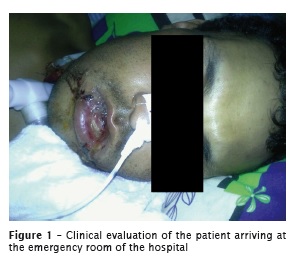
After being submitted to tracheostomy and soft tissue suturing, the patient developed difficulty in swallowing due to posterior projection of the tongue by edema and failure of bone structure, which compromised the muscle action. It was opted to install a nasogastric tube, which remained until the condition improves, when the patient was submitted to surgical reduction and fixation of comminuted bone fragments (figure 2).
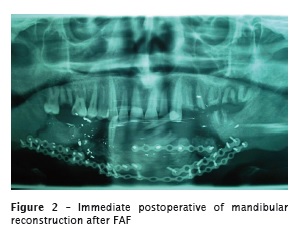
At seven months postoperatively, with no patient follow up for failure in outpatient appointments, he presented himself to the emergency room of the hospital complaining of pain in the jaw. At clinical examination, necrosis could be assessed by the exposure of synthesis material, purulent collection, fetid odor and fly larvae in surgical wound area (figure 3). The patient was hospitalized and Ivermectin™ was prescribed to control infestation; antibiotics to control infection of the surgical site; and analgesic to control acute pain. After 48 hours, he was surgically treated towards mechanical removal of the infestation by sequestrectomy, synthesis material removal and cleanliness of the exposed operative cavity. At 8 months of followingup, the patient showed good clinical outcome, without postoperative intercurrences.
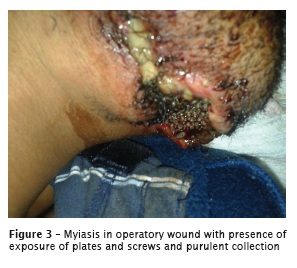
Case 2
Male patient, aged 43 years-old, victim of on running over remaining unconscious without hospital care for approximately 48 hours was referred to the Department of Oral and Maxillofacial Surgery of SJPHM 15 days after the accident complaining of wound on the upper lip and the presence of pain and swelling in the same region, without comorbidities or medical histories of systemic diseases, but referring abuse of drugs and alcohol.
The clinical examination showed upper lip edema with the presence of cavity on the internal side of the same region where it was observed local infestation with diagnosis of cutaneous myiasis (figure 4). It was performed mechanical debridement and sanitation of the infestation (figure 5). The patient recovered well without complications after treatment.
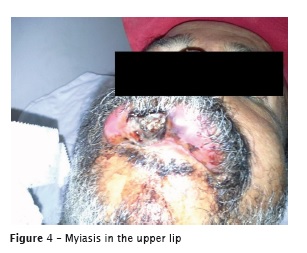
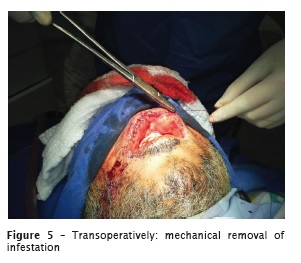
Case 3
Male patient aged 84 years-old with a history of stroke about 15 years ago, bedridden and in need of special care since the incident was referred to the emergency department of the aforementioned hospital with an intraoral bleeding and facial edema.
The patient exhibited midface swelling on the left side and gingival laceration lesion on the same side. At intraoral clinical examination, it could be observed larvae local infestation in maxillary sinus leading to the diagnosis of myiasis (figure 6).
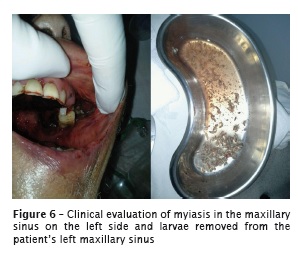
Mechanical removal was performed and abundant irrigation treatment of the disease. The patient evolved to death by medical problems before healing of the infestation.
Discussion
There are two criteria for the classification of myiasis: clinical and parasitological. Clinically, myiasis are classified according to their anatomical location in cutaneous, intestinal, and in cavity 10. In cutaneous myiasis the larva can produce a similar process to a furuncle, invade the dermis or preexisting injuries causing respectively the wound myiasis. The cavitary myiasis is that in which the larvae develop in natural cavities of the human body such as the mouth, nose, ears, eyes, vagina or anus. They are sub classified according to the type of cavity: oral, nasal, anal, vaginal myiasis, among others. The parasitological classification is based on both the biological behavior of the larvae and the type of the invaded tissue, separating them into three categories: mandatory, optional and accidental 10.
This event is most common in bedridden or people requiring special needs, because the caregiver is responsible for patient hygiene 2,6,9,15,16. Drug users sometimes cannot maintain basic postoperative care and they are exposed more easily to this type of situation. As can be observed in the reported cases, patients with a history of abuse of drugs, alcohol and neurological deficit were the carriers of parasitic infestation, due to lack of basic oral hygiene in surgical wound.
Mandible injuries are the most frequently injuries found in trauma treatment centers and constitute the second most frequent type in facial bones 8; they can involve a high number of subregions of the jaw. Currently, its main causes are physical aggression or firearm injury, followed by car accidents 7,8. The main risk factors are drug abuse and unemployment 7. The most affected age group is 27-35 years, approximately, and the proportion of men is around 72-89%, probably because it is this group that is most involved in activities related to risk behavior, such as crimes and drug use 4,8,15. Accordingly, drug abuse is widely discussed in the literature as an etiological risk factor for mandibular fractures, as well as for the presence of infections and morbidities acquired directly or indirectly by alcohol abuse or illicit drugs 13.
Standard guidelines for the management of oral myiasis do not exist, but few authors note that the ideal approach is to remove all larvae and perform surgical debridement 1,11, which was the treatment of choice in cases 1 and 2 with surgical mechanical removal of larvae leading to the healing of myiasis in both cases.
Treatment approaches other than procedural removal of the maggots include occlusion and administration of larvacides 11. These techniques can be used in addition to manual removal, or when manual removal is not possible 5. In the first reported case, Ivermectin™ was used to reduce the extent of mechanical debridement of the larvae, resulting in lower cosmetic and functional defects to the patient. Occlusion of the wound by pressure dressing promotes a decrease of oxygen which kills the larvae or induces them to move more superficially where they can be removed more easily. The choice of the combined treatment was due to the fact that the region has already surgically treated due to firearm injury with comminuted destruction of the patient's mandible. Through this procedure, a greater surgical access can be avoided resulting in a less aggressive myiasis.
Drug abuse results in various individual and social consequences and has a strong impact in terms of severe health complications, risky behaviors, violence, and social problems 18. The use of alcohol and illicit drugs is a common theme in patients with traumatic injury referred to trauma centers. In addition, associated with patient care issues, these common precipitants of clinician contact and costly hospitalizations particularly challenges our trauma care systems and compromises their ability to provide conventional medical services 12.
Substance use can also affect the outcomes of f racture t reatment st rateg ies, such as maxillomandibulary fixation, which rely on the patient's ability to follow postoperative instructions and maintain adequate oral care 12.
Shekarchizadeh et al. 17 demonstrated that poor oral health behavior among addicts withdrawal treatment, especially those less educated and at greatest risk for oral diseases. Educational and preventive strategies on oral health should be integrated into other care provided for addicts, taking into account distinct patient subgroups 17.
Patients with debilitating diseases constitute a risk group for oral myiasis and prevention of this disease is a challenge for caregivers and family members, especially in the case of patients with absence of lip sealing. The information and instructions to families, caregivers and long-stay hospitals, in relation to oral and environmental care, and routine assessment of oral health status of these patients are the main preventive strategies for this group 17. The care of patients with special needs for debilitating diseases or behavioral disorders (such as the case of patients with alcohol and illicit drugs abusive use) requires special attention. This type of complication reported in this study is easily prevented by basic health and personal hygiene. The installation of measures of basic sanitation care also provides a means of avoiding this type of manifestation.
Surgeons should be alert to several modalities of postoperative complications for their patients. The immediate attention and proper treatment for this manifestation type is essential for the satisfactory case prognosis.
Orientations of care given to the patient and caregivers are of paramount importance to avoid cases such as those described. Accordingly, preventive measures are still the best way to combat this infestation. Adequate corporal hygiene and sanitary education, by specific training of the population and health professionals are important factors and combat indirectly a series of other diseases, aiming to improve the quality of life of the general population 16.
The health assistance of people with drug and alcohol abuse becomes increasingly difficult to cure, to rehabilitate and to integrate them into society. Treatment and care for such patients becomes, thus, a challenge for the responsible team, requiring a multidisciplinary integration to improve prognosis and facilitate the resolution of the case.
References
1. Antunes AA, Santos TS, Avelar RL, Martins Neto EC, Macedo Neres B, Laureano Filho JR. Oral and maxillofacial myiasis: a case series and literature review. Oral Surg Oral Med Oral Pathol Oral Radiol Endod. 2011 Dec;112(6):81-5. [ Links ]
2. Candamourty R, Venkatachalam S, Yuvaraj V, Sujee C. Oral myiasis in an adult associated with filariasis and Hansen's disease. J Nat Sci Biol Med. 2013 Jan-Jun;4(1):259-62.
3. Cavuşoglu T, Apan T, Eker E, Vargel I, Saray A. Massive oculofacial myiasis infestation with Lucilia sericata. J Am Acad Dermatol. 2009 Jul;61(1):169- 70.
4. Cortes MGW, Marques AC, Guedes LJ. Severe gunshot comminuted mandible fracture: case report. Rev Méd Minas Gerais. 2010;20:415-8.
5. Costa FS, Belloti A, Farah GJ, Camarini ET. Treatment of myiasis resulting from complex facial trauma. Rev Cir Traumatol Buco-maxilo-fac. 2012 Jul-Sep;12(3):17-24.
6. Gabriel JG, Marinho SA, Verli FD, Krause RG, Yurgel LS, Cherubini K. Extensive myiasis infestation over a squamous cell carcinoma in the face. Case report. Med Oral Patol Oral Cir Bucal. 2008 Jan;13(1):9-11.
7. Greene D, Raven R, Carvalho G, Maas CS. Epidemiology of facial injury in blunt assault. Determinants of incidence and outcome in 802 patients. Arch Otolaryngol Head Neck Surg. 1997 Sep;123(9):923-8.
8. King RE, Scianna JM, Petruzzelli GJ. Mandible fracture patterns: a suburban trauma center experience. Am J Otolaryngol . 2004 Sep- Oct;25(5):301-7.
9. Manfrim AM, Cury A, Demeneghi P, Jotz G, Roithmann R. Nasal myiasis: case report and literature review. Int Arch Otorhinolaryngol. 2007;11(1):74-9.
10. Marquez AT, Mattos MS, Nascimento SB. Myiasis associated with some socioeconomic factors in five urban areas of the State of Rio de Janeiro. Rev Soc Bras Med Trop. 2007 Mar- Apr;40(2):175-80.
11. McGraw TA, Turiansky GW. Cutaneous myiasis. J Am Acad Dermatol. 2008 Jun;58(6):907-26.
12. Murphy DA. Substance use and facial injury. Oral Maxillofac Surg Clin North Am. 2010 May;22(2):231-8.
13. Pedreira RHS, Remencius L, Navarro MFL, Tomita NE. Oral health contions of drug-addicted patients undergoing a recuperation process. Rev Odontol Univ Cid São Paulo. 1999 Oct- Dec;13(4):395-9.
14. Reames MK, Christensen C, Luce EA. The use of maggots in wound debridement. Ann Plast Surg. 1988 Oct;21(4):388-91.
15. Ribeiro MTF, Sanglard-Oliveira CA, Naves MD, Ferreira EF, Vargas AMD, Abreu MHNG. Oral myiasis and Alzheimer disease: report of a clinical case. Rev Bras Geriatr Gerontol. 2012;15(4):805-11.
16. Sharma J, Mamatha GP, Acharya R. Primary oral myiasis: a case report. Med Oral Patol Oral Cir Bucal. 2008 Nov;13(11):714-6.
17. Shekarchizadeh H, Khami MR, Simin ZM, Virtanen JI. Oral health behavior of drug addicts in withdrawal treatment. BMC Oral Health. 2013;13(11):1-7.
18. UNODC. World Drug Report 2011. Vienna: United Nations Publication; 2011. Available from: URL:http://www.unodc.org/unodc/en/data-andanalysis/ WDR-2011.html.
 Corresponding author:
Corresponding author:
Cleverson Patussi
Rua Dr. Ovande do Amaral, n. 201 – Jardim das Américas
CEP 81520-060 – Curitiba – PR – Brasil
E-mail: cleversonpatussi@hotmail.com
Received for publication: October 28, 2013
Accepted for publication: January 22, 2014













